Mathematics Study Guide for the PRAXIS Test
Page 5
Geometry
Geometry is the other concept area assessed in the Algebra in Geometry section of the test. It is the study of and body of knowledge of points, lines, angles, and flat and solid shapes The word geometry originally meant earth measurement and has been and continues to be useful in surveying, construction, and astronomy.
Properties of Plane Shapes
Plane shapes are those that totally lie in one flat surface. Many of them have three or more line segments for sides, and they are called polygons. Polygons that have all sides and all angles congruent are called regular polygons. Circles and ellipses are examples of plane shapes that aren’t polygons.
Triangles

Retrieved from: http://www.kidsmathgamesonline.com/facts/geometry/triangles.html
- Triangles have 3 sides.
- The sum of their angles is \(180^{\circ}\).
- A scalene triangle has no congruent sides or angles.
- An acute triangle has all angles less than \(90^{\circ}\).
- An isosceles triangle has \(2\) congruent sides and \(2\) congruent angles.
- An equilateral triangle has \(3\) congruent sides and \(3\) congruent angles.
- A right triangle has one right angle.
- An obtuse triangle has one angle larger than \(90^{\circ}\).
Quadrilaterals

- Quadrilaterals have \(4\) sides.
- The sum of their angles is \(360^{\circ}\).
- Parallelograms have both pairs of opposite sides parallel.
- Rectangles are parallelograms that have \(4\) right angles.
- Squares are rectangles that have \(4\) congruent sides.
- Rhombuses are parallelograms with \(4\) congruent sides. (So a square is also a rhombus.)
- Trapezoids have only one pair of opposite sides parallel.
Other Polygons

The sum of angles in a pentagon is \(540^{\circ}\).
The sum of angles in a hexagon is \(720^{\circ}\).
The sum of angles in an octagon is \(1080^{\circ}\).
Other Plane Figures

Ellipses are unlikely to show up on the test, but circles may very well make an appearance. See more about circles below.
Angles
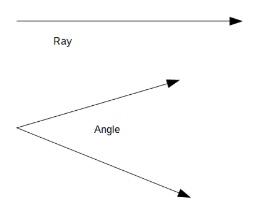
Angles are defined as two rays that share a common endpoint. In geometric figures, this is taken to also mean two line segments that share a common endpoint. The common endpoint is called the vertex of the angle.
Types of Angles

It may seem odd, but a straight line is also considered a straight angle, with a measure of \(180^{\circ}\). Any point on the line can be considered the vertex.
\[\begin{array}{c|l} \text{Angle Measure} & \text{Angle Type}\\ \hline \text{Less than } 90^{\circ} & \text{Acute}\\ \text{Equal to } 90^{\circ} & \text{Right}\\ \text{Greater than } 90^{\circ} \text{but not} 180^{\circ} & \text{Obtuse}\\ \text{Equal to }180^{\circ} & \text{Straight}\\ \end {array}\]Angle Properties
You should know a few basic properties of angles.

Adjacent Angles— Angles like \(\angle 1\) and \(\angle 2\) above that share a common side are known as adjacent angles.

Vertical Angles—At the intersection of two lines, angles \(x\) and \(y\) are called vertical angles or opposite angles. They are always congruent.

Angles in Parallelograms—The diagram shows an example of a parallelogram, where, like all parallelograms, opposite angles are congruent, and consecutive angles add up to \(180^{\circ}\). (They are supplementary.)

Angles Formed By Parallel Lines—In the diagram we have parallel lines \(m\) and \(n\) that are intersected by line \(k\), called a transversal. Notice the pattern of the angle measures.
The angles that are adjacent to each other will always add up to \(180^{\circ}\).
The angles that are opposite each other (vertical angles) are always congruent.
The angle pattern around line \(m\) exactly matches the pattern around line \(n\).
Congruency

For line segments and angles, congruent means having the same measures.
For polygons, congruent means all corresponding sides have the same measure, and all corresponding angles have the same measure. The corresponding sides and angles are the ones that are in matching positions in each triangle.
In the given figure, corresponding angle pairs are:
\(\angle A \text{ and }\angle D\), \(\angle B \text{ and }\angle B\), \(\angle C \text{ and }\angle F\).
Corresponding side pairs are:
\(\overline{AB} \text{ and } \overline{DE}\), \(\overline{BC} \text{ and } \overline{EF}\), \(\overline{AC} \text{ and } \overline{DF}\)
The symbol for is congruent to is \(\cong\). In the figure above, \(\triangle ABC \cong \triangle DEF\)
Similarity

In casual use, the word similar means that two things are a lot alike. In geometry, it means they are the same exact shape, but not the same size. More exactly, two similar figures have all their corresponding angles congruent. The two pentagons above are similar, but not congruent.
Formulas for Circles
Know the three basic measures of a circle as shown below. You will need to know how to calculate the circumference and area of circles.
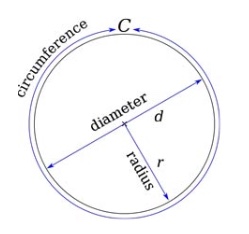
Retrieved from: http://www.kidsmathgamesonline.com/facts/geometry/circles.html
Area
Use \(A=\pi r^{2}\) to calculate the area of a circle. Know the formula and use \(\pi=3.14\).
For example, what is the area of a circle with a diameter of 12 cm?
\(A=3.14 \times (6\ \text{ cm})^{2}\)
\(A=3.14 \times 36\ \text{ cm}^{2}\)
\(A=113.04\ \text{ cm}^{2}\)
Circumference
Use \(C=2\pi r\) or \(C=\pi d\) to calculate the circumference of a circle. Again, know the formula and use \(\pi = 3.14\). For example.
What is the circumference of a bolt that is \(0.50\) inches in diameter?
\(C = \pi d\)
\(C = 3.14 \times 0.50 \text{ inches}\)
\(C = 1.57 \text { inches}\)
Other Formulas
There are a few other formulas you’ll need to know and know how to use.
Rectangle

The perimeter of a rectangle is the sum of the four sides: \(P=2l+2w\).
The area of a rectangle is the product of length and width. \(A=lw\).
Triangle
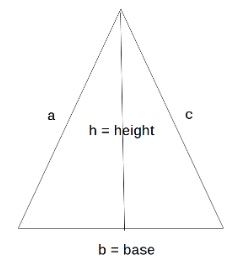
The area of a triangle is found using \(A=\frac{1}{2}bh\).
For example: What is the area of a right triangle with legs of 10 cm and 9 cm?
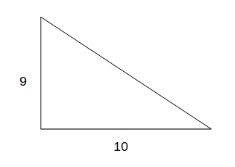
Remember that the legs of a right triangle are the sides of the right angle, and because the \(9\) is perpendicular to the \(10\), the \(9\) is the height in this case, and the \(10\) is the base.
\[A=\frac{1}{2}\times10 \text{ cm}\times 9 \text{cm}\] \[A=45 \text{cm}^{2}\]The perimeter is found, like all perimeters, by adding all the sides. \(P=a+b+c\).
Volume of a Rectangular Prism
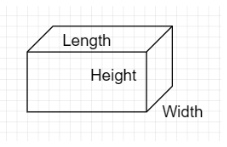
The volume of a rectangular prism (box) can be found using \(A=length \times width \times height\), or \(A=lwh\) for short.
For example, what is the volume of a box that is \(0.60\) m by \(0.80\) m by \(1.10\) m?
\[V=0.60 \text{ m} \times 0.80 \text{ m} \times 1.10 \text{ m}\] \[V=0.528 \text{ m}^{3}\]All Study Guides for the PRAXIS Test are now available as downloadable PDFs